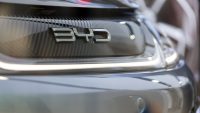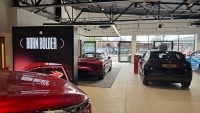 Saab is alive! We’ve reported about the on/off saga seemingly non-stop over the past few months here at Car Dealer Magazine.
Saab is alive! We’ve reported about the on/off saga seemingly non-stop over the past few months here at Car Dealer Magazine.
The final instalment, though, saw the revival of the firm, under supercar maker Spyker. Not only is it saved, but there’s also a brand-new model to mark the rebirth. Enter the BMW 5 Series-rivaling Saab 9-5.
They haven’t done the impossible and developed an all-new car in weeks, of course. The 9-5 was actually developed completely under GM stewardship; it is thus based on a stretched version of the Insignia platform. Even so, there are no visual links with GM cars at all.
The styling is confident, modern and distinctive, while remaining true to Saab’s aeroplane-inspired heritage. An imposing car on the road – not least because of its length – it makes a refreshing alternative to the German norm of Audi, BMW and Mercedes.
We like the inside, too. Traditional Saab quirks like the old ignition key between the seats get a modern twist and the bulky dashboard wraps around the driver to give that ‘cockpit’ feel of cars like the old 99 and 900. The aircraft influence continues with an optional head-up display projecting speed, revs and navigation info on to the windscreen and the options sheet is packed with all manner of gadgets and gizmos.
Typically comfy seats mean it feels like a Saab too. It’s just a shame the acres of plastic fail to live up to the premium pretensions. Audi can rest easy on this score. Oh, and those sleek looks also rob rear headroom and make rear visibility somewhat limited. Best spec parking sensors then. The boot is usefully big, however, and an optional divider on floor-mounted rails keeps things from rattling about.
More tradition lies in wait under the bonnet. All Saabs get a turbocharged engine, be they diesel or petrol, harking right back to the pioneering Saab 99 Turbos of the 70s. The range will eventually kick off with a 180bhp 1.6 turbo petrol but for now makes do with a 220bhp 2.0 and a 300bhp 2.8 V6. The 160bhp 2.0 TiD diesel will later be joined by a 190bhp twin-turbo TTiD version too.
Most engines are okay, if not groundbreaking. We can’t see the point in the V6 petrol, though, and reckon things will get more interesting when the powerful diesel arrives, along with that downsized 1.6-litre petrol turbo.
Likewise the handling. Front-drive Saab 9-5s dominate the range; here, Saab’s engineers at least able to eke a degree of steering feel out of the Insignia-based architecture. Which is more than can be said for their former colleagues at Vauxhall.
 Faster cars, though, get an all-inclusive four-wheel drive (XWD in Saab speak) suspension with the ‘HyPer Strut’ front suspension seen on the Insignia VXR. The flagship 2.8 T and 2.0 TTiD get the full works and you can pick and choose the various chassis options on the other models depending on how you want your 9-5 to drive.
Faster cars, though, get an all-inclusive four-wheel drive (XWD in Saab speak) suspension with the ‘HyPer Strut’ front suspension seen on the Insignia VXR. The flagship 2.8 T and 2.0 TTiD get the full works and you can pick and choose the various chassis options on the other models depending on how you want your 9-5 to drive.
It’s all very sophisticated the more you spend; maybe this is why the 300bhp 2.8 T doesn’t feel quite as punchy as you might want it to. Also, this flagship model’s auto-only transmission is prone to hunting for ratios.
It does at least have enough power to give the XWD chassis a bit of a workout, the three-way DriveSense switch on this model offering Comfort, Intelligent and Sport settings. These make a big difference to the way it drives and in Sport the firmer steering, suspension and sharper throttle response are all noticeable. Not that the 9-5 ever strays from the path of solid, safe grip and go.
The 2.8-litre T is thirsty. 26.9mpg will win no fans – we think the smaller four-pot petrols are much more impressive, and more in keeping with Saab heritage. Company buyers will inevitably be drawn to the diesels though, the entry-level 2.0 TiD offering respectable 53.2mpg and 139g/km. Best warn customers if they want an auto though – CO2 climbs to 179g/km and mpg drops to 41.5. That’s a huge drop!
Saabs have a loyal fanbase and the 9-5 should go a long way to winning them back to the brand. That’s enough to see Saab survive, but will it help the firm take on the German establishment? There, the jury is out. It’s certainly something different though…
































